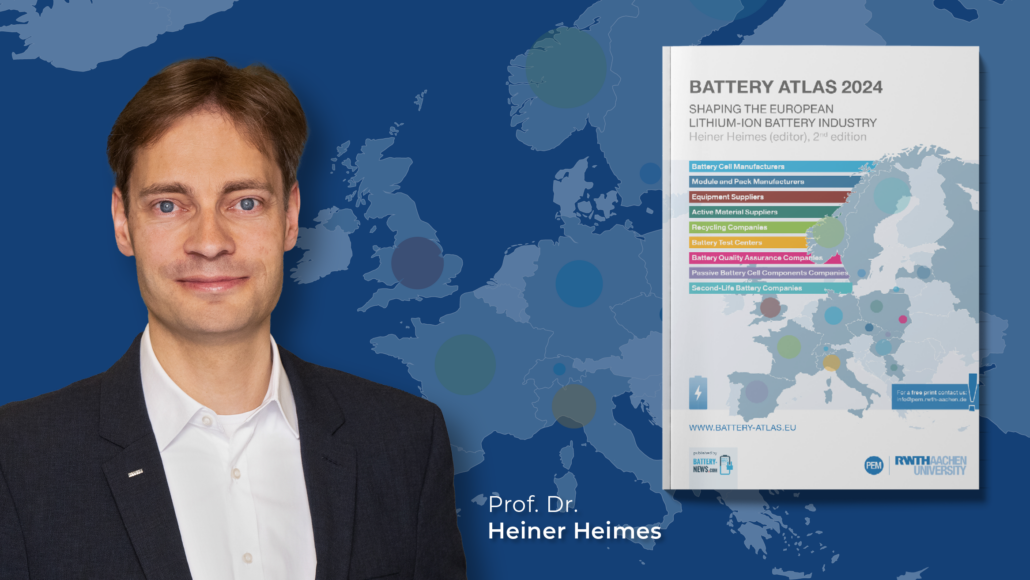How well is Europe positioned in all areas of the battery industry? The 2024 edition of the Battery Atlas maps the commitment and distribution of players along the entire value chain. In an exclusive interview with Battery-News, Professor Heiner Heimes, Management Member of the Chair of Production Engineering of E-Mobility Components (PEM) of RWTH Aachen University and editor of the Battery Atlas, explains what opportunities are opening up for Europe – and what challenges lie ahead.
Battery-News: Two years have passed since the first Battery Atlas was published. What has happened in that time?
Professor Heiner Heimes: It is indeed impressive to see how quickly the European battery industry has grown within two years. As Europeans, we can be both grateful for and proud of this development. We must always bear in mind the circumstances we are currently operating, researching, and living in. The global political situation shows us that we are well advised to make ourselves as independent as possible regarding critical components. The lithium-ion battery is one of them. To achieve the greatest possible independence here, the development of different industries around the lithium-ion battery is crucial – and a lot has happened in this respect.
Battery-News: How is this reflected in the current Battery Atlas?
Heimes: We have broadened our view this year. This has resulted in nine thematic European maps that illustrate the status quo of the various industrial sectors. As last time, we are looking at cell manufacturers, module and pack producers, suppliers of systems and battery active materials as well as recycling companies and battery test centers. For 2024, we have also taken a look at the market players for battery quality assurance, passive cell components, and second-life applications of batteries after their first life in electric vehicles – for example in stationary energy storage systems. The new Battery Atlas therefore now covers most of the battery life cycle – from active and passive cell components to recycling or the further use of spent battery cells.
“Europe is still a decisive market in the battery world despite its high energy costs.”
Professor Heiner Heimes
Battery-News: What special insights have you gained from your observations?
Heimes: For example, that Europe is still a decisive market in the battery world despite its high energy costs. Apart from Germany, Hungary is also developing into a center of battery production. The increasing capacities in cell production are opening up new opportunities in module and pack production. This applies both to the automotive sector and to the growing field of stationary energy storage. This in turn has led to an increasing number of machine and system manufacturers establishing themselves in Europe. They highly benefit from the fact that their customers – the battery cell manufacturers – are based in Europe, too. There is also an increasing number of companies dedicated to quality assurance in the immediate vicinity, and we see more and more suppliers of battery materials setting up in Europe. These companies have recognized that cell production is dependent on stable supply chains.
Battery-News: What is the situation in the recycling sector in particular? It lags behind battery production, but also seems to arrive later in the industrial ramp-up.
Heimes: Both is true, but a lot is happening in this area at the moment: numerous recycling companies with promising innovative approaches in terms of efficiency and sustainability are being founded in Europe in a short space of time. As not all batteries used in electric vehicles have to be recycled immediately, the number of players in the stationary storage sector is also growing – as is the number of test centers, as every lithium-ion battery has to undergo various acceptance and performance tests before it is approved. The fact that many companies in Europe are developing batteries at the same time results in a correspondingly high testing effort, from which test centers benefit.
“In Germany, individual vehicle manufacturers want to hire around 20,000 specialists for battery production by 2030 – but have only been able to fill 1,000 positions so far.”
Professor Heiner Heimes
Battery-News: In addition to all the success, does Europe also face challenges?
Heimes: We have reason to be confident, but it’s not all sunshine and roses. You can see this, for example, if you look at a recent study by the English “Verdict” portal. It concludes that jobs in the battery sector are the most difficult to fill in the entire technology industry. In Germany, individual vehicle manufacturers want to hire around 20,000 specialists for battery production by 2030 – but have only been able to fill 1,000 positions so far. The training of such specialists usually takes place as part of funded research and development projects, which is why it is important that universities, research institutions, and companies continue to receive government support for battery research projects. However, this is precisely where the German government has recently announced massive funding cuts.
Battery-News: How can the battery industry in Europe best arm itself against adversity?
Heimes: Whether and how Europe can hold its own in global competition will also depend on how well the many different market players network with each other. If they succeed in establishing collaboration along the entire value chain, we can offer services as turnkey solutions “made in Europe”, jointly exploit economies of scale, and pool financial resources for research and development in order to bring new technologies to market even faster. Then Europe will also be on a promising path when it comes to expanding electric mobility. If we overcome national borders, investments in battery production in one country can strengthen mechanical and plant engineering in another nation or lead to the use of battery test centers in yet another country. If we support each other in the development of new projects, we will succeed in making the European battery industry robust and securing the long-term supply of this essential component of our future mobility.
The 2024 Battery Atlas is available as a free download. The team of authors includes Gerrit Bockey, Artur Scheibe, Natalia Soldan, Niklas Kisseler, Benedict Späth, Merlin Frank and Jan Felix Plumeyer.
The 2024 Battery Atlas is available for download on the PEM RWTH Aachen University website. Individual maps are also available in the Battery Atlas section of Battery News.



